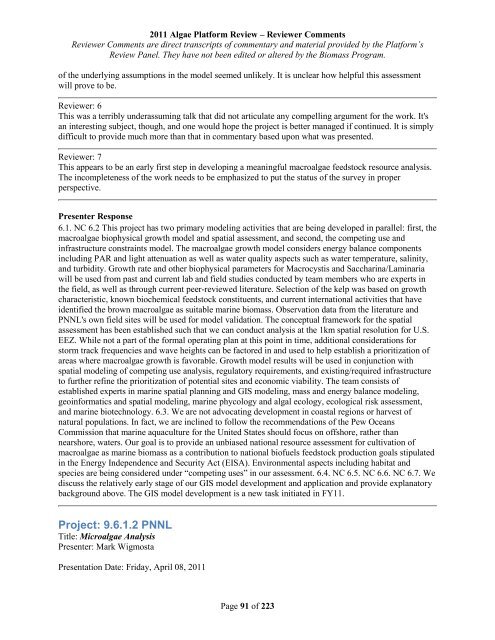Reviewer Comments - EERE
Reviewer Comments - EERE
Reviewer Comments - EERE
Create successful ePaper yourself
Turn your PDF publications into a flip-book with our unique Google optimized e-Paper software.
2011 Algae Platform Review – <strong>Reviewer</strong> <strong>Comments</strong><br />
<strong>Reviewer</strong> <strong>Comments</strong> are direct transcripts of commentary and material provided by the Platform’s<br />
Review Panel. They have not been edited or altered by the Biomass Program.<br />
of the underlying assumptions in the model seemed unlikely. It is unclear how helpful this assessment<br />
will prove to be.<br />
<strong>Reviewer</strong>: 6<br />
This was a terribly underassuming talk that did not articulate any compelling argument for the work. It's<br />
an interesting subject, though, and one would hope the project is better managed if continued. It is simply<br />
difficult to provide much more than that in commentary based upon what was presented.<br />
<strong>Reviewer</strong>: 7<br />
This appears to be an early first step in developing a meaningful macroalgae feedstock resource analysis.<br />
The incompleteness of the work needs to be emphasized to put the status of the survey in proper<br />
perspective.<br />
Presenter Response<br />
6.1. NC 6.2 This project has two primary modeling activities that are being developed in parallel: first, the<br />
macroalgae biophysical growth model and spatial assessment, and second, the competing use and<br />
infrastructure constraints model. The macroalgae growth model considers energy balance components<br />
including PAR and light attenuation as well as water quality aspects such as water temperature, salinity,<br />
and turbidity. Growth rate and other biophysical parameters for Macrocystis and Saccharina/Laminaria<br />
will be used from past and current lab and field studies conducted by team members who are experts in<br />
the field, as well as through current peer-reviewed literature. Selection of the kelp was based on growth<br />
characteristic, known biochemical feedstock constituents, and current international activities that have<br />
identified the brown macroalgae as suitable marine biomass. Observation data from the literature and<br />
PNNL's own field sites will be used for model validation. The conceptual framework for the spatial<br />
assessment has been established such that we can conduct analysis at the 1km spatial resolution for U.S.<br />
EEZ. While not a part of the formal operating plan at this point in time, additional considerations for<br />
storm track frequencies and wave heights can be factored in and used to help establish a prioritization of<br />
areas where macroalgae growth is favorable. Growth model results will be used in conjunction with<br />
spatial modeling of competing use analysis, regulatory requirements, and existing/required infrastructure<br />
to further refine the prioritization of potential sites and economic viability. The team consists of<br />
established experts in marine spatial planning and GIS modeling, mass and energy balance modeling,<br />
geoinformatics and spatial modeling, marine phycology and algal ecology, ecological risk assessment,<br />
and marine biotechnology. 6.3. We are not advocating development in coastal regions or harvest of<br />
natural populations. In fact, we are inclined to follow the recommendations of the Pew Oceans<br />
Commission that marine aquaculture for the United States should focus on offshore, rather than<br />
nearshore, waters. Our goal is to provide an unbiased national resource assessment for cultivation of<br />
macroalgae as marine biomass as a contribution to national biofuels feedstock production goals stipulated<br />
in the Energy Independence and Security Act (EISA). Environmental aspects including habitat and<br />
species are being considered under “competing uses” in our assessment. 6.4. NC 6.5. NC 6.6. NC 6.7. We<br />
discuss the relatively early stage of our GIS model development and application and provide explanatory<br />
background above. The GIS model development is a new task initiated in FY11.<br />
Project: 9.6.1.2 PNNL<br />
Title: Microalgae Analysis<br />
Presenter: Mark Wigmosta<br />
Presentation Date: Friday, April 08, 2011<br />
Page 91 of 223




